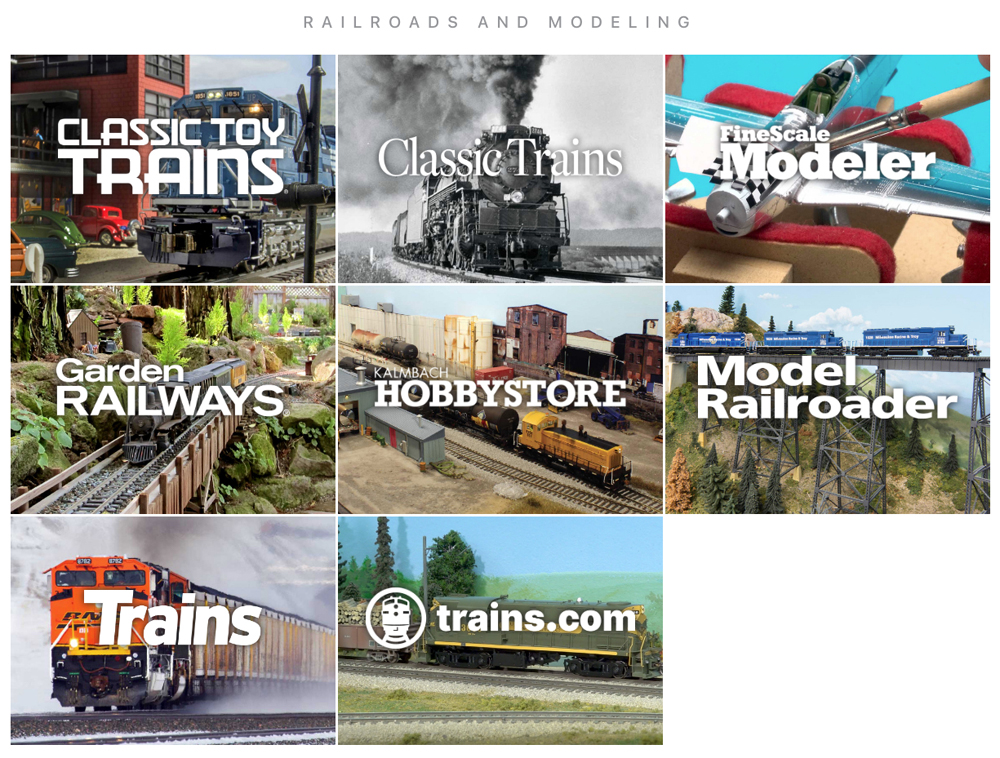Head on over to Firecrown Media and scroll down, and you’ll discover** some familiar faces in an unusual spot:

It’s no longer news that Kalmbach has sold most of its assets to Firecrown Media. (**The notable exception is Discover Magazine.) The news broke May 1st and has surely been a hot topic at train clubs and local hobby shops (for those who still have one). It’ll likely be dissected in depth at railway modelling conventions and shows including this year’s NMRA National.
And, of course, it’s burning up the electrons online.
There’s lots of blather and speculation out there. But if you want some serious independent insight, Stephen Lee‘s website, Sprue Pie with Frets, offers the best analysis of the sale I’ve read to date. (I’ve mentioned his site before – if you’re an enthusiast of any modelling hobby and not reading it, you’re missing out.)
It’s no secret that changes have been happening in the hobby but over the past several months there have been some big ones. In the UK, a venerable hobby shop (Hattons) announced in October it would close its doors after 77 years. Then in January, the country’s largest annual train show – the Warley National Model Railway Exhibition – threw in its towel, too.
Most of us have similar examples: Local hobby shops closing, manufacturers ceasing business, train shows downsizing or disappearing entirely, and so on. But despite much pearl clutching, the hobby keeps chugging along.
Still, Kalmbach’s exit hit a lot of people like a runaway train. Mostly, I suspect, because of nostalgia.
Yes, it was shocking – but not surprising given the steadily shrinking page count in its flagship magazine, Model Railroader, and general grumblings amongst modellers about the editorial content. The reality is, many of us (all of us?) are getting a lot of railway modelling content online these days. There’s a firehose on the other side of our screens, spewing material at us 24/7. We couldn’t watch / listen / read it all if we tried.
In that environment, a traditional print publication has to do something really special to entice people to subscribe.
To Kalmbach’s credit, they tried with initiatives like Model Railroader Video Plus – and I thought MRV+ would eventually replace the magazine, given that our hobby is so visual and animated. Why look at a series of pictures demonstrating a technique, when a video offers so much more? Why read about a model railway layout, when a video report could present it in action?
Either Kalmbach’s strategy wasn’t working, or it was but Firecrown made an offer too good to refuse. It doesn’t matter in the end: As bystanders, all we can do is wait and see what happens. And who knows? It might turn out just fine.
After all, it did for Railroad Model Craftsman magazine. When Carstens Publications shut off the lights for good in August, 2014, there wasn’t even a buyer in sight. Fast forward a decade, an ownership change, and two editors and RMC looks better than ever, with consistently great content and much improved production values.
While there’s not much we can do about MR and Trains as bystanders, there’s a lot we can do as hobbyists.
For starters, if we want magazines we can contribute to them. All magazines are looking for good content and writing for them isn’t that hard: We’re not asked to write a literary masterpiece, and the article’s subject will ne something we love and know well. That’s one third of the battle.
The “second third” is taking pictures: They have to be good. But that’s a skill anybody can learn. What’s more, today’s cameras are much more forgiving than those loaded with 35mm slide film, which was the standard for hobby magazines 20 years ago. And we can review out photos immediately, making it simple to reshoot as needed.
The “third third” is understanding what the magazine needs and delivering that. Editors will help – they need your material! – but you have to ask questions. Friends who have also contributed to magazines can also help – perhaps by reading a draft and making suggestions. If you leave your ego at the door, you’ll learn something.a
The effort is worth it: you’ll see your article in print, and earn some decent coin to pas your hobby budget!
There are other things we can do:
We can give a clinic at Railway Prototype Modelling meets. We can speak at conventions. We can organize layout building and operating round-robins. We can blog to share our work and our ideas. We can produce videos or podcasts. (We can even publish books and other print materials. To provide two examples from friends, Lance Mindheim has released an excellent series of self-published books and Chris Mears recently produced his own print magazine.)
Above all, we can share our skills with our friends – either by mentoring or through barter (eg: “You paint this locomotive for me and I’ll build that structure for you”.) Mentoring – learning and sharing skills so we can build what we can’t buy – is the most powerful response to uncertainty in the hobby. The changes aren’t done but the more skills one learns, the less one is dependent upon others to make the hobby possible.
Finally, I’m thinking less about the fate of the magazines that are changing hands, and more about the employees at Kalmbach that may be affected by this transfer of ownership. These will be uncertain times for them, and I wish them all the best as they navigate the weeks and months ahead.